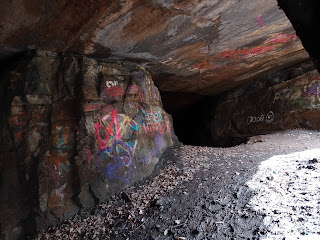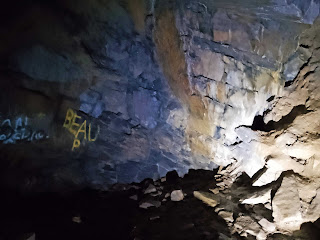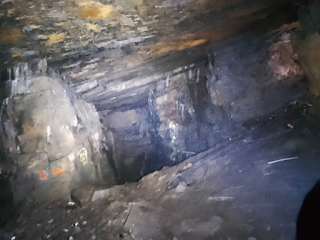While the precise origins of the caverns remain unclear, historical records point to sandstone quarrying beginning as early as 1700. The 1840s Ordnance Survey referenced the site as Rainford Old Delph, hinting at a long and potentially forgotten industrial past. Interestingly, the main entrances appear more recent compared to the deeper tunnels, suggesting an evolution in access points over time.
The ownership and workforce behind these tunnels are lost to time. However, the caverns' story takes an unexpected turn in the 20th century. Local history archives reveal that the surrounding woodlands transitioned from a game reserve for the Earl of Derby to an ammunition storage facility during World War II, catering to the nearby anti-aircraft position at Crank. After the war, the game reserve ceased operation, leaving the caverns in their current, relatively undisturbed state.
Today, Crank Caverns remain accessible through a nearby public footpath. However, the site has suffered from fly-tipping, with rubble, plastic waste, and animal remains marring the landscape. Despite this, the caverns continue to hold a magnetic pull for curious explorers, many drawn in by the whispers of local legends.
The first set, the most prominent, features seven entrances leading into a large main cavern. This cavern was formed through the pillar and stall mining method, where stone pillars were left in place to support the roof. A sealed passageway existed behind this chamber, leading to an even more extensive network. This network was once accessible from a concealed entrance in nearby woodland, but it's now filled in. Interestingly, rumors persist that the cellar of the Stork Inn in Billinge might connect to this hidden labyrinth.
The second set of caverns lies northwest of the first and can be found at the base of a deep ditch. The largest cavern here is the aptly named "Elephant Cave," featuring a ledge requiring ropes to climb and rumored to lead deeper into the network. Adjoining the Elephant Cave is the smaller, gated "Mousey." Despite its unassuming size, the Mousey leads to a much older and deeper network of tunnels. True to its name, the entrance to this deeper section, nicknamed "Hell," is an extremely tight crawl that takes several minutes to navigate.
The tunnels in this deeper section are a stark contrast to the newer caverns. Here, one encounters long and impressive stalactites and stalagmites, formed over vast stretches of time. A stone-lined shaft, repeatedly filled by a farmer, once provided access to even deeper passages. The infill from this shaft marks the point where the newer mining tunnels branch off from the older natural caverns. Many have attempted to excavate here, but the near-impenetrable mixture of stone, mud, and clay has thwarted all efforts.
Unfortunately, recent landfill has further constricted access to these older caverns, making them extremely dangerous and prone to collapse. While technically accessible as of October 2023, venturing into these areas is strongly discouraged.
This revised version offers a clearer structure, highlights intriguing details, and emphasizes the potential dangers of exploring these unstable caverns.
Crank Caverns: A Labyrinth of Legends
Crank Caverns are shrouded in mystery, fueled by numerous myths and legends. Perhaps the most famous tale speaks of Catholics seeking refuge during King Henry VIII's persecution (1491-1547). However, historical records show mining in the area only began around 1730, casting doubt on this legend.
The caverns themselves are rumored to be vast, with some stories suggesting hidden connections to distant locations like Up Holland in Lancashire and churches in St Helens. One particularly intriguing legend describes a seven-mile tunnel leading from St Helens Town Hall all the way to the caverns, supposedly used for secret executions.
Adding to the intrigue are tales of ferocious dwarves guarding the caverns' depths. In the late 18th century, four children vanished while exploring the caves. The sole survivor, traumatized and petrified, spoke of bearded little men who attacked his friends and chased him. He described stumbling upon human bones before escaping through a narrow opening, just as a hand reached for his ankle.
These disappearances, and similar incidents, sparked concern among authorities. An expedition of heavily armed soldiers ventured into the caverns, reportedly finding a disturbing scene: a pile of human bones and the ruins of an unidentified, ancient church. Grotesque gargoyles adorned the altar, while an eerie glow emanated from three large candles. The soldiers recounted an unsettling feeling of being watched and hearing disembodied voices in a strange language.
One account mentions the discovery of a child's head and possible cannibalistic rituals. Following a second investigation, the caverns were either sealed shut with gunpowder or collapsed naturally. The truth behind what transpired within remains a mystery.









































No comments:
Post a Comment